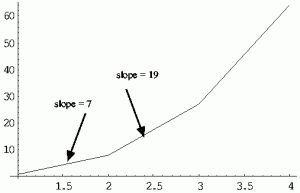Sqrt[x^2 + 1]exactly (case sensitive, square bracket) in the first box and x (lower case) in the second box, then press the query button.




| f (x) | f ′(x) | Examples |
| (f ± g)′ | f ′± g ′ | (x + ex) ′ |
| (f g) ′ | f ′g + f g ′ | (f g h) ′ |
| (f/g) ′ | (f ′g − f g ′)/g2 | x/sin x |
| f (g (x)) ′ | f ′(g (x)) g ′(x) | (x2 + 1)10 |
| xα | αxα−1 | x5, √x, √{x3} |
| ex | ex | ex2, 2x |
| ln x | 1/x | ln (x3) |
| sin x | cos x | sin (1+x2) |
| cos x | −sin x | cos (x2) |
| tan x | 1/cos 2 x | tan (x2+1) |
| arcsin x | 1/√{1−x2} | arcsin (arcsin (x)) |
| arccos x | −1/√{1−x2} | |
| arctan x | 1/(1+x2) |
|
|
|
|
|
|
|
|
| x | f (x) |
| 1 | 1 |
| 2 | 8 |
| 3 | 27 |
| 4 | 64 |

|
| (3) |
|
| (5) |
|
| (8) |
| (9) |
|
|
|
|
| (12) |
| (13) |
| x | 0.0 | 0.1 | 0.2 | 0.3 | 0.4 | 0.5 | 0.6 | 0.7 | 0.8 | 0.9 | 1.0 |
| f(x) | 0 | 0.0998 | 0.1986 | 0.2955 | 0.3894 | 0.4794 | 0.5646 | 0.6442 | 0.7173 | 0.7833 | 0.8414 |
|
|
|
| (16) |
| (17) |
|
|
|
Sqrt[x^2 + 1]exactly (case sensitive, square bracket) in the first box and x (lower case) in the second box, then press the query button.
